Solar Energy Production in India and Commonly Used Technologies—An Overview
Abstract
:1. Introduction
2. Solar Energy Technologies and Systems
2.1. Concentrated Solar Power
2.2. Solar Cell
2.3. Solar Cell Module, Panel, and Array
2.4. Photovoltaic Systems, Efficiency, and Cost
3. Diurnal Changes in Sunlight Intensity and Solar Energy Production
4. Monocrystalline and Polycrystalline Solar Photovoltaic Systems
5. Single Unit and Utility Grid Solar Power Systems
5.1. PV Power Production System and Growth
5.2. Scope of Solar Module Recycling
5.3. Reviving Solar Industry Post COVID-19 and Future Prospects
6. Challenges in Performance Management of PV System
7. Conclusions
Author Contributions
Funding
Institutional Review Board Statement
Informed Consent Statement
Data Availability Statement
Acknowledgments
Author Disclaimer
Conflicts of Interest
Nomenclature
| Symbols | Used for |
| PV | photovoltaic |
| KWh | kilowatt-hour |
| GW | Gigawatts |
| PTC | parabolic trough collector |
| CSP | concentrated solar power |
| SPT | Solar power tower |
| CdTE | Cadmium telluride |
| CPV | concentrator photovoltaics |
| SiO2 | Silicon dioxide |
| AC | alternating current |
| DC | direct current |
References
- Top 17 Solar Panel Manufacturers in India. 2021. Available online: https://www.solarfeeds.com/mag/top-solar-panel-manufacturers-in-india (accessed on 28 September 2021).
- Khare Saxena, A.; Saxena, S.; Sudhakar, K. Solar energy policy of India: An overview. CSEE J. Power Energy Syst. 2020, 1, 1–32. [Google Scholar] [CrossRef]
- Solangi, K.H.; Islam, M.R.; Saidur, R.; Rahim, N.A.; Fayaz, H. A review on global solar energy policy. Renew. Sustain. Energy Rev. 2011, 15, 2136–2149. [Google Scholar] [CrossRef]
- Sharma, N.K.; Tiwari, P.K.; Sood, Y.R. Solar energy in India: Strategies, policies, perspectives and future potential. Renew. Sustain. Energy Rev. 2012, 16, 933–941. [Google Scholar] [CrossRef]
- Irfan, M.; Zhao, Z.Y.; Ikram, M.; Gilal, N.G.; Li, H.; Rehman, A. Assessment of India’s energy dynamics: Prospects of solar energy. J. Renew. Sustain. Energy 2020, 12, 1–17. [Google Scholar] [CrossRef]
- Mishra, T.; Rabha, A.; Kumar, U.; Arunachalam, K.; Sridhar, V. Assessment of solar power potential in a hill state of India using remote sensing and Geographic Information System. Remote Sens. Appl. Soc. Environ. 2020, 19, 100370. [Google Scholar] [CrossRef]
- Dixit, S. Solar technologies and their implementations: A review. Mater. Today Proc. 2020, 28, 2137–2148. [Google Scholar] [CrossRef]
- Bulut, U.; Menegaki, A. Solar energy-economic growth nexus in top 10 countries with the highest installed capacity. Energy Sources Part B Econ. Plan. Policy 2020, 15, 297–310. [Google Scholar] [CrossRef]
- Solar Energy. Country Rankings (irena.org). Available online: https://irena.org/Statistics/View-Data-by-Topic/Capacity-and-Generation/Country-Rankings (accessed on 28 September 2021).
- Photovoltaic Capacity Increased to 505 GW- Evwind. Available online: https://www.evwind.es/2019/06/21/photovoltaic-cumulative-capacity-increased-approximately-25-to-at-least-505-gw/67686 (accessed on 28 September 2021).
- IEA PVPS, Snapshot of Global PV Markets 2020, op. cit. note 1, p. 14. Based on Cumulative Capacity in Operation at end-2019 and Assumes Close to Optimum Siting, Orientation and Long-Term Average Weather Conditions. Available online: https://www.ren21.net/gsr-2020/#target_10_5 (accessed on 12 August 2021).
- Jebasingh, V.K.; Herbert, G.J. A review of solar parabolic trough collector. Renew. Sustain. Energy Rev. 2016, 54, 1085–1091. [Google Scholar] [CrossRef]
- Jebasingh, V.K.; Divya, J.J.; Arunkumar, T. Performance study on eutectic molten salt as a high temperature working fluid in the parabolic trough collector. Int. J. Ambient Energy 2019, 1–5. [Google Scholar] [CrossRef]
- Jebasingh, V.K.; Divya, J.J.; Arunkumar, T. Assessment of circular and elliptical absorber tube in solar parabolic trough collector. Int. J. Ambient Energy 2019, 1–6. [Google Scholar] [CrossRef]
- Upadhyay, B.H.; Patel, A.J.; Ramana, P.V. A detailed review on solar parabolic trough collect. J. Ambient Energy 2019, 1–21. [Google Scholar] [CrossRef]
- Aseri, T.K.; Sharma, C.; Kandpal, T.C. Cost reduction potential in parabolic trough collector based CSP plants: A case study for India. Renew. Sustain. Energy Rev. 2021, 138, 110658. [Google Scholar] [CrossRef]
- Energy, B. Renewables 2017 Global Status Report. Renewable Energy Policy Network for the 21st Century. Paris: REN21. 2016. Available online: https://www.ren21.net/wp-content/uploads/2019/05/GSR2017_Full-Report_English.pdf (accessed on 8 November 2021).
- Fuqiang, W.; Ziming, C.; Jianyu, T.; Yuan, Y.; Yong, S.; Linhua, L. Progress in concentrated solar power technology with parabolic trough collector system: A comprehensive review. Renew. Sustain. Energy Rev. 2017, 79, 1314–1328. [Google Scholar] [CrossRef]
- Awan, A.B.; Khan, M.N.; Zubair, M.; Bellos, E. Commercial parabolic trough CSP plants: Research trends and technological advancements. Sol. Energy 2020, 211, 1422–1458. [Google Scholar] [CrossRef]
- Solar PACES. CSP Projects around the World. 2019. Available online: https://www.solarpaces.org/csp-technologies/csp-projects-around-the-world (accessed on 12 May 2021).
- IRENA, Statistics, International Renewable Energy Agency. 2020. Available online: https://www.irena.org/Statistics (accessed on 28 September 2021).
- Elbeh, M.B.; Sleiti, A.K. Analysis and optimization of concentrated solar power plant for application in arid climate. Energy Sci. Eng. 2021, 9, 1–14. [Google Scholar] [CrossRef]
- Kumar, A.; Prakash, O.; Dube, A. A review on progress of concentrated solar power in India. Renew. Sustain. Energy Rev. 2017, 79, 304–307. [Google Scholar] [CrossRef]
- Mills, D. Advances in solar thermal electricity technology. Sol. Energy 2004, 76, 19–31. [Google Scholar] [CrossRef]
- Sharma, A. A comprehensive study of solar power in India and World. Renew. Sustain. Energy Rev. 2011, 15, 1767–1776. [Google Scholar] [CrossRef]
- Wang, K.; Li, M.J.; Zhang, Z.D.; Min, C.H.; Li, P. Evaluation of alternative eutectic salt as heat transfer fluid for solar power tower coupling a supercritical CO2 Brayton cycle from the viewpoint of system-level analysis. J. Clean. Prod. 2021, 279, 123472. [Google Scholar] [CrossRef]
- Yagli, H. Examining the receiver heat loss, parametric optimization and exergy analysis of a solar power tower (SPT) system. Energy Sources Part A Recovery Util. Environ. Eff. 2020, 42, 2155–2180. [Google Scholar] [CrossRef]
- Hamanah, W.M.; Salem, A.; Abido, M.A.; Qwbaiban, A.M.; Habetler, T.G. Solar Power Tower Drives: A Comprehensive Survey. IEEE Access 2021. [CrossRef]
- Ivanpah, World’s Largest Solar Plant in California Desert. Available online: http://www.brightsourceenergy.com/ivanpah-solar-project#.YXDSEBrMKUk (accessed on 29 September 2021).
- Noor Ouarzazate Solar Complex, Morocco-Power Technology. Available online: https://www.power-technology.com/projects/noor-ouarzazate-solar-complex (accessed on 29 September 2021).
- Megalim Solar Power-The Technology—Wix.com. Available online: https://megalimsolar.wixsite.com/megalim-solar-power/the-technology (accessed on 29 September 2021).
- Solar Photovoltaic Cell Basics, Department of Energy. Available online: https://www.energy.gov/eere/solar/solar-photovoltaic-cell-basics (accessed on 29 September 2021).
- Solar Cell Efficiency-PVEducation. Available online: https://www.pveducation.org/pvcdrom/solar-cell-operation/solar-cell-efficiency (accessed on 29 September 2021).
- Solar Performance and Efficiency, Department of Energy. Available online: https://www.energy.gov/eere/solar/solar-performance-and-efficiency (accessed on 29 September 2021).
- Photovoltaic cell-Energy Education. Available online: https://energyeducation.ca/encyclopedia/Photovoltaic_cell (accessed on 29 September 2021).
- Stevenson, R. Slimmer solar cells. Ingenia 2014, 53, 33–37. [Google Scholar]
- Zhang, H.L.; Van, G.T.; Baeyens, J.; Degrève, J. Photovoltaics: Reviewing the European feed-in-tariffs and changing PV efficiencies and costs. Sci. World J. 2014, 2014. [Google Scholar] [CrossRef] [PubMed]
- How a Solar Cell Works-American Chemical Society How a Solar Cell Works—American Chemical Society. Available online: acs.org (accessed on 30 September 2021).
- Patel, M.R. Solar Photovoltaic Power System. In Wind and Solar Power Systems; CRC Press LLC.: Boca Raton, FL, USA, 1999; pp. 138–157. [Google Scholar]
- Cell, Modules and Arrays—FSEC Energy Research Center Cells, Modules, and Arrays. Available online: https://energyresearch.ucf.edu/consumer/solar-technologies/solar-electricity-basics/cells-modules-panels-and-arrays/ (accessed on 30 September 2021).
- Crabtree, G.W.; Lewis, N.S. Solar energy conversion. Phys. Today 2007, 60, 37–42. [Google Scholar] [CrossRef]
- Solar Module—Definition, Solar Terms, Sunrun. Available online: https://www.sunrun.com/go-solar-center/solar-terms/definition/solar-module (accessed on 30 September 2021).
- Solar PV Modules. Available online: https://www.solardirect.com/archives/pv/pvlist/pvlist.htm (accessed on 30 September 2021).
- Annual Solar Module Production Worldwide, Statista. Available online: https://www.statista.com/statistics/668764/annual-solar-module-manufacturing-globally (accessed on 30 September 2021).
- Top 5 Largest Solar Power Plants of the World, SolarInsure. Available online: https://www.solarinsure.com/largest-solar-power-plants (accessed on 26 September 2021).
- With 2245 MW of Commissioned Solar Projects, World’s Largest Solar Park is Now at Bhadla. Available online: https://mercomindia.com/world-largest-solar-park-bhadla (accessed on 26 September 2021).
- World’s Largest Solar Plant Goes Online in China—PV Magazine. Available online: https://www.pv-magazine.com/2020/10/01/worlds-largest-solar-plant-goes-online-in-china (accessed on 28 September 2021).
- Pavagada Solar Park, Karnataka. Available online: https://www.power-technology.com/projects/pavagada-solar-park-karnataka (accessed on 26 September 2021).
- Benban Solar Park, Egypt, World’s Biggest Solar Photovoltaic. Available online: https://www.nsenergybusiness.com/projects/benban-solar-park (accessed on 28 September 2021).
- The Biggest Solar Power Plants in the World—Power Technology. Available online: https://www.power-technology.com/features/the-worlds-biggest-solar-power-plants (accessed on 28 September 2021).
- Noor Abu Dhabi—Emirates Water and Electricity Company. Available online: https://www.ewec.ae/en/power-plants/noor-abu-dhabi (accessed on 28 September 2021).
- Mohammed bin Rashid Al Maktoum Solar Park. Available online: http://www.dewa.gov.ae/en/about-us/media-publications/latest-news/2019/03/mohammed-bin-rashid-al-maktoum-solar-park (accessed on 28 September 2021).
- World’s Largest Solar Park in Kurnool on the Cusp of Completion. Available online: https://mercomindia.com/worlds-largest-solar-park-kurnool-cusp-completion (accessed on 15 December 2021).
- Power Generation Begins at Kunta Ultra Mega Solar Project. Available online: https://www.business-standard.com/article/pti-stories/power-generation-begins-at-kunta-ultra-mega-solar-project-116051001059_1.html (accessed on 15 December 2021).
- Solar Energy Overview. Available online: https://mnre.gov.in/solar/current-status (accessed on 27 September 2021).
- RUMS Rewa Ultra Mega Solar Ltd. Available online: http://rumsl.mp.gov.in/rumsl-about-us/ (accessed on 26 September 2021).
- Kamuthi Solar Power Project. Available online: https://www.wikiwand.com/en/Kamuthi_Solar_Power_Project (accessed on 26 September 2021).
- Solar Power Capacity at Charanka Solar Park to Touch 790 MW. Available online: https://www.dnaindia.com/ahmedabad/report-solar-power-capacity-at-charanka-solar-park-to-touch-790-mw-2607133 (accessed on 26 September 2021).
- Kadapa Solar Park—CECP–EU. Available online: https://www.cecp-eu.in/resource-center/post/solar-parks-38/solar-parks/kadapa-solar-park (accessed on 15 December 2021).
- Welspun Solar MP Project-Neemuch. Available online: https://neemuch.nic.in/en/district-produce/welspun-solar-mp-project (accessed on 26 September 2021).
- Solar Photovoltaic Plant Sakri—Federal Foreign Office—The German. Available online: https://india.diplo.de/in-en/themen/sakri/1992864 (accessed on 26 September 2021).
- Maharashtra I—SolarArise. Available online: https://www.solararise.com/maharashtra1.html (accessed on 26 September 2021).
- Chowdhury, M.S.; Rahman, K.S.; Chowdhury, T.; Nuthammachot, N.; Techato, K.; Akhtaruzzaman, M.; Tiong, S.K.; Sopian, K.; Amin, N. An overview of solar photovoltaic panels’ end-of-life material recycling. Energy Strategy Rev. 2020, 27, 100431. [Google Scholar] [CrossRef]
- Xu, Y.; Li, J.; Tan, Q.; Peters, A.L.; Yang, C. Global status of recycling waste solar panels: A review. Waste Manag. 2018, 75, 450–458. [Google Scholar] [CrossRef]
- Sica, D.; Malandrino, O.; Supino, S.; Testa, M.; Lucchetti, M.C. Management of end-of-life photovoltaic panels as a step towards a circular economy. Renew. Sustain. Energy Rev. 2018, 82, 2934–2945. [Google Scholar] [CrossRef]
- IRENA Renewable Power Generation Costs in 2019. Available online: https://www.irena.org/publications/2020/Jun/Renewable-Power-Costs-in-2019 (accessed on 1 October 2021).
- Efficiency of Solar PV, Then, Now and Future Efficiency of Solar PV, Then, Now and Future—Solar Photovoltaic. Available online: lafayette.edu (accessed on 1 October 2021).
- Tijjani, J.; Hamza, B.; Igwenagu, S. The Effect of Humidity and Temperature on the Efficiency of Solar Power Panel Output in Dutsin-Ma Local Government Area (LGA), Nigeria. J. Asian Sci. Res. 2020, 10, 1–16. [Google Scholar] [CrossRef] [Green Version]
- Average Solar Radiation, PVEducation. Available online: https://www.pveducation.org/pvcdrom/properties-of-sunlight/average-solar-radiation (accessed on 1 October 2021).
- Sandelic, M.; Sangwongwanich, A.; Blaabjerg, F. Reliability evaluation of PV systems with integrated battery energy storage systems: Dc-coupled and ac-coupled configurations. Electronics 2019, 8, 1059. [Google Scholar] [CrossRef] [Green Version]
- Solar Power’s Greatest Challenge Was Discovered 10 Years Ago. It Looks Like a Duck. Available online: https://www.vox.com/energy-and-environment/2018/3/20/17128478/solar-duck-curve-nrel-researcher (accessed on 1 October 2021).
- What Will California Do With Too Much Solar? KQED. Available online: https://www.kqed.org/science/610026/what-will-california-do-with-too-much-solar (accessed on 1 October 2021).
- Go Green—California ISO. Available online: http://www.caiso.com/informed/Pages/CleanGrid/default.aspx (accessed on 1 October 2021).
- Hollemann, C.; Haase, F.; Rienäcker, M.; Barnscheidt, V.; Krügener, J.; Folchert, N.; Brendel, R.; Richter, S.; Großer, S.; Sauter, E.; et al. Separating the two polarities of the POLO contacts of an 26.1%-efficient IBC solar cell. Sci. Rep. 2020, 10, 1–15. [Google Scholar]
- Reduce of Reflection and Recombination Losses by Surface Texturization. Available online: https://www.helmholtz-berlin.de/forschung/oe/se/silizium-photovoltaik/arbeitsgebiete/heteroemittersolarzellen/oberflaechen/oberflaechen11_de.html (accessed on 1 October 2021).
- Beaucarne, G.; Choulat, P.; Chan, B.T.; Dekkers, H.; John, J.; Poortmans, J. Etching, texturing and surface decoupling for the next generation of Si solar cells. Photovolt. Int. 2008, 1, 66–71. [Google Scholar]
- Richhariya, G.; Kumar, A.; Samsher. Solar Cell Technologies, Photovoltaic Solar Energy Conversion; Gorjian, S., Shukla, A., Eds.; Academic Press: Cambridge, MA, USA, 2020; pp. 27–50. [Google Scholar]
- Kitahara, K.; Ishii, T.; Suzuki, J.; Bessyo, T.; Watanabe, N. Characterization of defects and stress in polycrystalline silicon thin films on glass substrates by Raman microscopy. Int. J. Spectrosc. 2011, 632139, 14. [Google Scholar] [CrossRef] [Green Version]
- Monocrystalline Solar Panel: Solar Cells That Have Longevity Up to 30 Years. Available online: https://economictimes.indiatimes.com/small-biz/productline/power-generation/monocrystalline-solar-panel-solar-cells-that-have-longevity-up-to-30-years/articleshow/69140542.cms?from=mdr (accessed on 2 October 2021).
- Russell, H.P. Solar Photovoltaic Systems. In Solar Energy, Photovoltaics and Domestic Hot Water, 1st ed.; Russell, H.P., Ed.; Academic Press: Cambridge, MA, USA, 2014; pp. 75–92. ISBN 9780124201552. [Google Scholar]
- Polycrystalline Solar Panels: Cheap Yet Efficient Long Lasting Solar Panels. Available online: https://economictimes.indiatimes.com/small-biz/productline/power-generation/polycrystalline-solar-panels-cheap-yet-efficient-long-lasting-solar-panels/articleshow/69130611.cms?from=mdr (accessed on 3 October 2021).
- Monocrystalline vs Polycrystalline Solar Panels. Available online: https://ases.org/monocrystalline-vs-polycrystalline-solar-panels (accessed on 2 October 2021).
- Mughal, S.; Sood, Y.R.; Jarial, R.K. A review on solar photovoltaic technology and future trends. Int. J. Sci. Res. Comput. Sci. Eng. Inf. Technol. 2018, 4, 227–235. [Google Scholar]
- Wen, C.; Yang, Y.J.; Ma, Y.J.; Shi, Z.Q.; Wang, Z.J.; Mo, J.; Li, T.C.; Li, X.H.; Hu, S.F.; Yang, W.B. Sulfur-hyperdoped silicon nanocrystalline layer prepared on polycrystalline silicon solar cell substrate by thin film deposition and nanosecond-pulsed laser irradiation. Appl. Surf. Sci. 2019, 476, 49–60. [Google Scholar] [CrossRef]
- Solar Energy Market to Reach 224 Billion With A CAGR of 20.5%—Growth Market Reports. Available online: https://www.prnewswire.com/news-releases/solar-energy-market-to-reach-224-billion-with-a-cagr-of-20-5---growth-market-reports-301272673.html (accessed on 3 October 2021).
- Ali, W.; Farooq, H.; Rehman, A.U.; Awais, Q.; Jamil, M.; Noman, A. Design considerations of stand-alone solar photovoltaic systems. In Proceedings of the 2018 International Conference on Computing, Electronic and Electrical Engineering (ICE Cube), Quetta, Pakistan, 12–13 November 2018; pp. 1–6. [Google Scholar]
- Awasthi, A.; Shukla, A.K.; Murali Manohar, S.R.; Dondariya, C.; Shukla, K.N.; Porwal, D.; Richhariya, G. Review on sun tracking technology in solar PV system. Energy Rep. 2020, 6, 392–405. [Google Scholar] [CrossRef]
- Martínez, R.; Bolea, Y.; Grau, A.; Martínez, H. LPV model for PV cells and fractional control of DC/DC converter for photovoltaic systems. In Proceedings of the 2011 IEEE International Symposium on Industrial Electronics, Gdansk, Poland, 27–30 June 2011; pp. 1069–1074. [Google Scholar]
- Apollo Power Systems Solar Rooftop Solutions, Apollo Power Pvt Ltd. Available online: apollopowersystems.com (accessed on 3 October 2021).
- Types of Solar PV Power Supply Systems-Learning Electrical Engineering. Available online: https://www.electricalengineeringtoolbox.com/2019/11/types-of-solar-pv-power-supply-systems.html (accessed on 3 October 2021).
- World Now Has 583.5 GW of Operational PV. Available online: https://www.pv-magazine.com/2020/04/06/world-now-has-583-5-gw-of-operational-pv (accessed on 3 October 2021).
- Physical Progress (Achievements), Ministry of New and Renewable Energy|Government of India. mnre.gov.in. Available online: https://mnre.gov.in/the-ministry/physical-progress (accessed on 14 September 2019).
- IEA. Renewable Energy Market Update. IEA, Paris. 2020. Available online: https://www.iea.org/reports/renewable-energy-market-update (accessed on 5 December 2021).
- Nekouaslazadeh, A. Recycling Waste Solar Panels (c-Si & CdTe) in Sweden [Dissertation]. 2021. Available online: http://urn.kb.se/resolve?urn=urn:nbn:se:lnu:diva-105045 (accessed on 12 August 2021).
- Jain, S.; Sharma, T.; Gupta, A.K. End-of-life management of solar PV waste in India: Situation analysis and proposed policy framework. Renew. Sustain. Energy Rev. 2022, 153, 111774. [Google Scholar] [CrossRef]
- Sciuto, G.L.; Capizzi, G.; Salvatore, C.O.C.O.; Shikler, R. Geometric shape optimization of organic solar cells for efficiency enhancement by neural networks. In Advances on Mechanics, Design Engineering and Manufacturing; Springer: Cham, Switzerland, 2017; pp. 789–796. [Google Scholar]
- Capizzi, G.; Lo Sciuto, G.; Napoli, C.; Shikler, R.; Woźniak, M. Optimizing the organic solar cell manufacturing process by means of AFM measurements and neural networks. Energies 2018, 11, 1221. [Google Scholar] [CrossRef] [Green Version]
- Tian, X.; Stranks, S.D.; You, F. Life cycle assessment of recycling strategies for perovskite photovoltaic modules. Nat. Sustain. 2021, 4, 821–829. [Google Scholar] [CrossRef]
- Gautam, A.; Shankar, R.; Virat, P. End-of-life solar photovoltaic e-waste assessment in India: A step towards a circular economy. Sustain. Prod. Consum. 2021, 26, 65–77. [Google Scholar] [CrossRef]
- Binek, A.; Petrus, M.L.; Huber, N.; Bristow, H.; Hu, Y.; Bein, T.; Docampo, P. Recycling perovskite solar cells to avoid lead waste. ACS Appl. Mater. Interfaces 2016, 8, 12881–12886. [Google Scholar] [CrossRef] [PubMed] [Green Version]
- Yousef, S.; Tatariants, M.; Denafas, J.; Makarevicius, V.; Lukošiūtė, S.I.; Kruopienė, J. Sustainable industrial technology for recovery of Al nanocrystals, Si micro-particles and Ag from solar cell wafer production waste. Sol. Energy Mater. Sol. Cells 2019, 191, 493–501. [Google Scholar] [CrossRef]
- Goel, M. Solar rooftop in India: Policies, challenges and outlook. Green Energy Environ. 2016, 1, 129–137. [Google Scholar] [CrossRef] [Green Version]
- Mantri, S.R.; Kasibhatla, R.S.; Chennapragada, V.K.B. Grid-connected vs. off-grid solar water pumping systems for agriculture in India: A comparative study. Energy Sources Part A Recovery Util. Environ. Eff. 2020, 1–15. [Google Scholar] [CrossRef]
- Sadhu, M.; Chakraborty, S.; Das, N.; Sadhu, P.K. Role of solar power in sustainable development of India. TELKOMNIKA Indones. J. Electr. Eng. 2015, 14, 34–41. [Google Scholar] [CrossRef]
- Global Energy Review. 2021. Available online: https://www.iea.org/reports/global-energy-review-2021/renewables (accessed on 5 December 2021).
- PV Magazine. 2021. Available online: https://www.pv-magazine.com/2021/10/28/india-added-8-8-gw-of-solar-in-first-nine-months-of-2021 (accessed on 5 December 2021).
- Reilly, J.M.; Chen, Y.H.H.; Jacoby, H.D. The COVID-19 effect on the Paris agreement. Humanit. Soc. Sci. Commun. 2021, 8, 1–4. [Google Scholar] [CrossRef]
- A Brief Guide on Renewable Energy. A Brief Guide to Renewables, UNFCCC. 2021. Available online: https://globalchange.mit.edu/publication/17556 (accessed on 5 December 2021).
- PV Magazine. 2021. Available online: https://www.pv-magazine.com/2021/09/20/indian-solar-manufacturers-go-big-on-high-output-modules (accessed on 5 December 2021).
- Solar Irrigation in India. 2021. Available online: https://www.downtoearth.org.in/blog/energy/solar-irrigation-can-transform-indian-agriculture-enhance-livelihoods-of-small-to-marginal-farmers-77608 (accessed on 5 December 2021).
- Sahoo, S.K.; Manoharan, B.; Sivakumar, N. Introduction: Why perovskite and perovskite solar cells? In Perovskite Photovoltaics; Academic Press: Cambridge, MA, USA, 2018; pp. 1–24. [Google Scholar]
- Global Monocrystalline Solar Cells. 2021. Available online: https://www.databridgemarketresearch.com/reports/global-monocrystalline-solar-cell-mono-si-market (accessed on 5 December 2021).
- Polaris. 2021. Available online: https://www.polarismarketresearch.com/industry-analysis/polysilicon-market (accessed on 5 December 2021).
- Parabolic trough. Energy Gov. 2021. Available online: https://www.energy.gov/eere/solar/parabolic-trough (accessed on 5 December 2021).
- Reve. 2021. Available online: https://www.evwind.es/2020/01/21/china-largest-100-mw-parabolic-trough-concentrated-solar-power-plant-connected-to-the-grid/73162 (accessed on 5 December 2021).
- Hayat, M.B.; Ali, D.; Monyake, K.C.; Alagha, L.; Ahmed, N. Solar energy—A look into power generation, challenges, and a solar-powered future. Int. J. Energy Res. 2019, 43, 1049–1067. [Google Scholar] [CrossRef]
- Palacios, A.; Barreneche, C.; Navarro, M.E.; Ding, Y. Thermal energy storage technologies for concentrated solar power–A review from a materials perspective. Renew. Energy 2020, 156, 1244–1265. [Google Scholar] [CrossRef]
- Lewis, N.S.; Nocera, D.G. Powering the planet: Chemical challenges in solar energy utilization. Proc. Natl. Acad. Sci. USA 2006, 103, 15729–15735. [Google Scholar] [CrossRef] [Green Version]
- Tomson, T. Transient processes of solar radiation. Theor. Appl. Climatol. 2013, 112, 403–408. [Google Scholar] [CrossRef]
- Tomson, T.; Hansen, M. Dynamic properties of clouds Cumulus humilis and Cumulus fractus extracted by solar radiation measurements. Theor. Appl. Climatol. 2011, 106, 171–177. [Google Scholar] [CrossRef]
- Lappalainen, K.; Valkealahti, S. Recognition and modeling of irradiance transitions caused by moving clouds. Sol. Energy 2015, 112, 55–67. [Google Scholar] [CrossRef]
- Espinosa-Gavira, M.J.; Agüera-Pérez, A.; Palomares-Salas, J.C.; González-de-la-Rosa, J.J.; Sierra-Fernández, J.M.; Florencias-Oliveros, O. Cloud motion estimation from small-scale irradiance sensor networks: General analysis and proposal of a new method. Sol. Energy 2020, 202, 276–293. [Google Scholar] [CrossRef]
- Scolari, E.; Sossan, F.; Paolone, M. Irradiance prediction intervals for PV stochastic generation in microgrid applications. Sol. Energy 2016, 139, 116–129. [Google Scholar] [CrossRef]
- Järvelä, M.; Lappalainen, K.; Valkealahti, S. Characteristics of the cloud enhancement phenomenon and PV power plants. Sol. Energy 2020, 196, 137–145. [Google Scholar] [CrossRef]
- Yordanov, G.H.; Saetre, T.O.; Midtgård, O.M. Extreme over irradiance events in Norway: 1.6 suns measured close to 60 N. Sol. Energy 2015, 115, 68–73. [Google Scholar]
- Emck, P.; Richter, M. An upper threshold of enhanced global shortwave irradiance in the troposphere derived from field measurements in tropical mountains. J. Appl. Meteorol. Climatol. 2008, 47, 2828–2845. [Google Scholar] [CrossRef]
- Lappalainen, K.; Kleissl, J. Analysis of the cloud enhancement phenomenon and its effects on photovoltaic generators based on cloud speed sensor measurements. J. Renew. Sustain. Energy 2020, 12, 043502. [Google Scholar] [CrossRef]
- Luoma, J.; Kleissl, J.; Murray, K. Optimal inverter sizing considering cloud enhancement. Sol. Energy 2012, 86, 421–429. [Google Scholar] [CrossRef]
- Wurster, T.S.; Schubert, M.B. Mismatch loss in photovoltaic systems. Sol. Energy 2014, 105, 505–511. [Google Scholar] [CrossRef]
- El-Dein, M.S.; Kazerani, M.; Salama, M.M. An optimal total cross-tied interconnection for reducing mismatch losses in photovoltaic arrays. IEEE Trans. Sustain. Energy 2012, 1, 99–107. [Google Scholar]
- Lappalainen, K.; Valkealahti, S. Effects of PV array layout, electrical configuration and geographic orientation on mismatch losses caused by moving clouds. Sol. Energy 2017, 144, 548–555. [Google Scholar] [CrossRef]
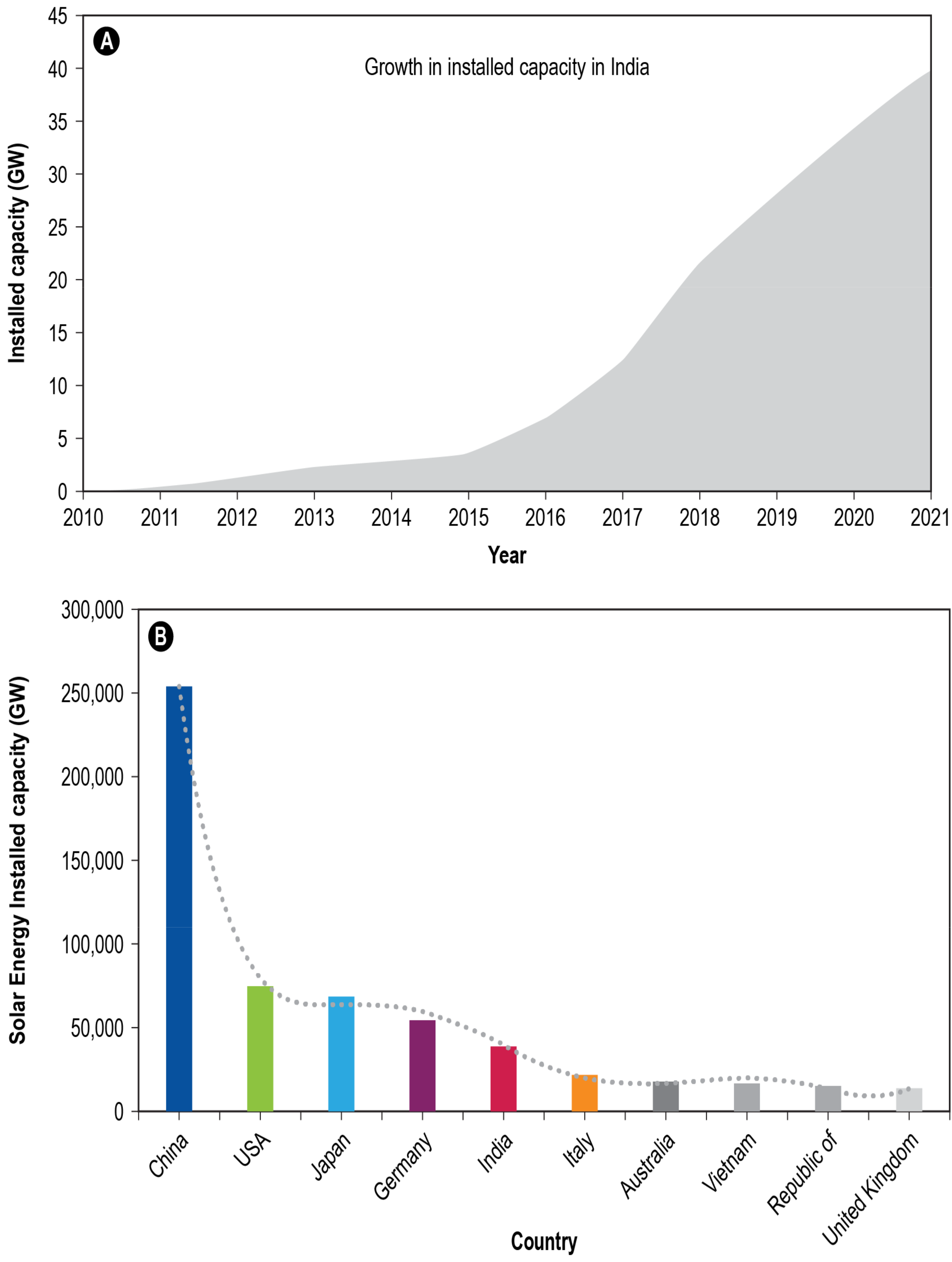




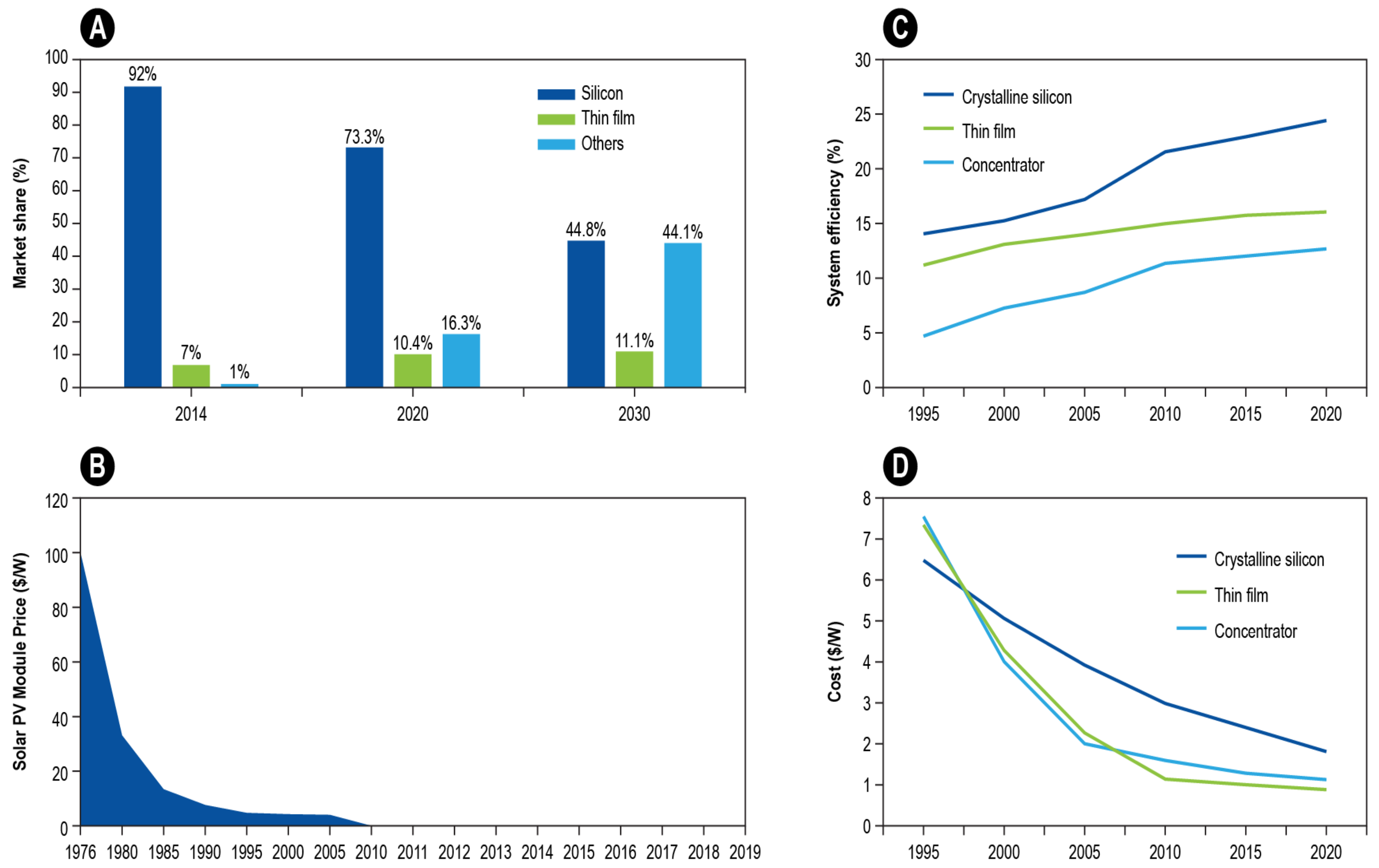

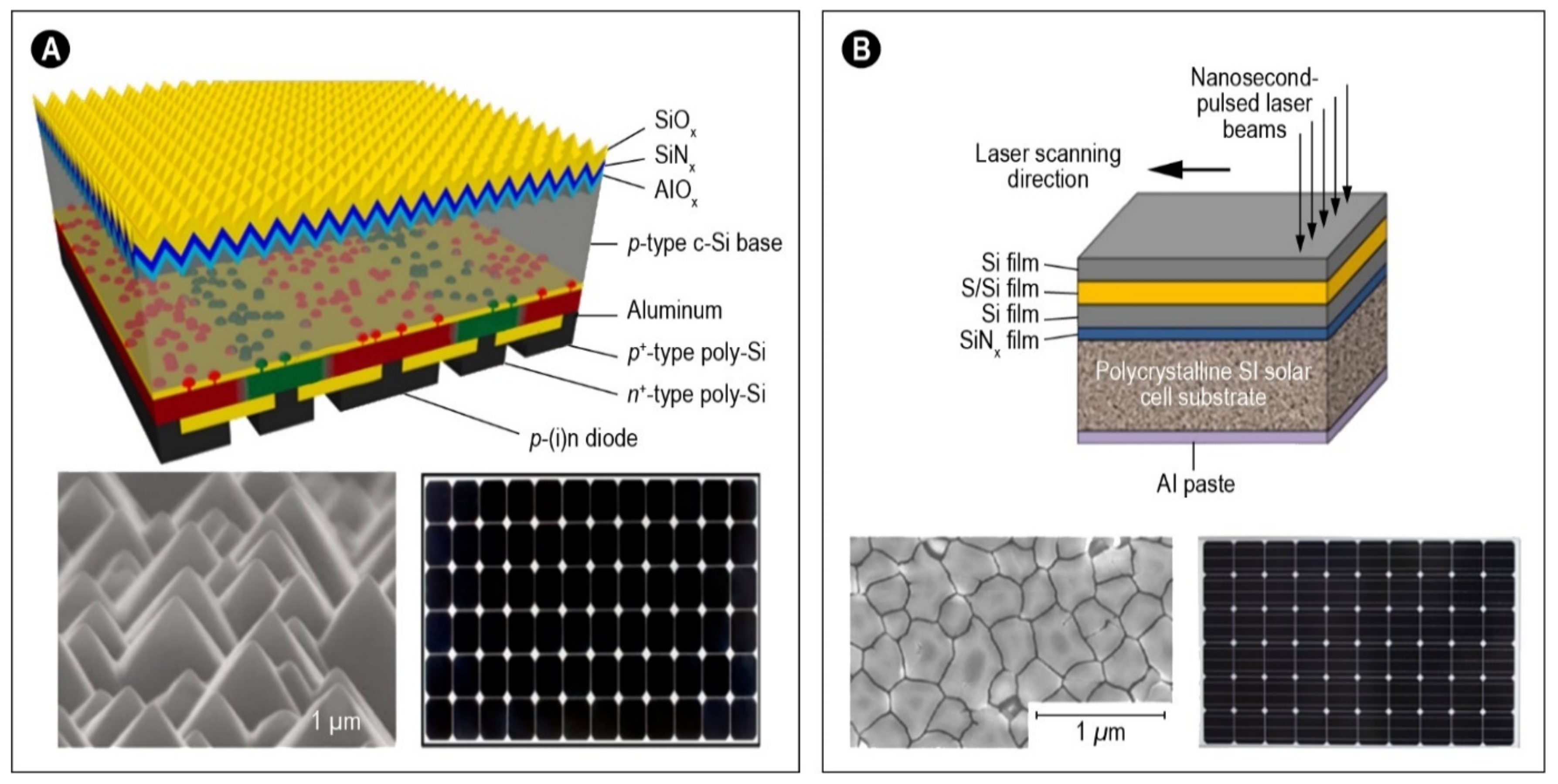
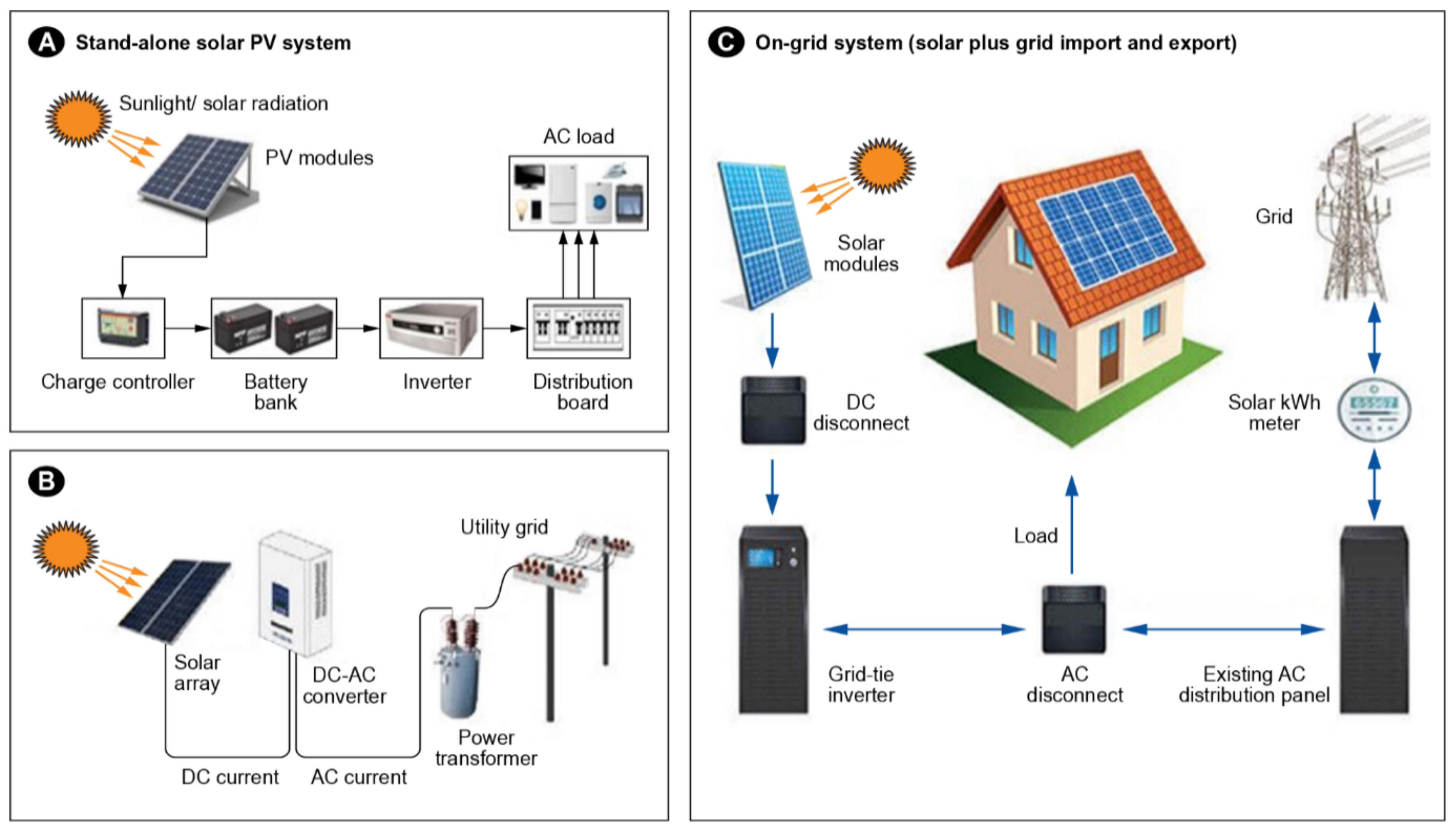
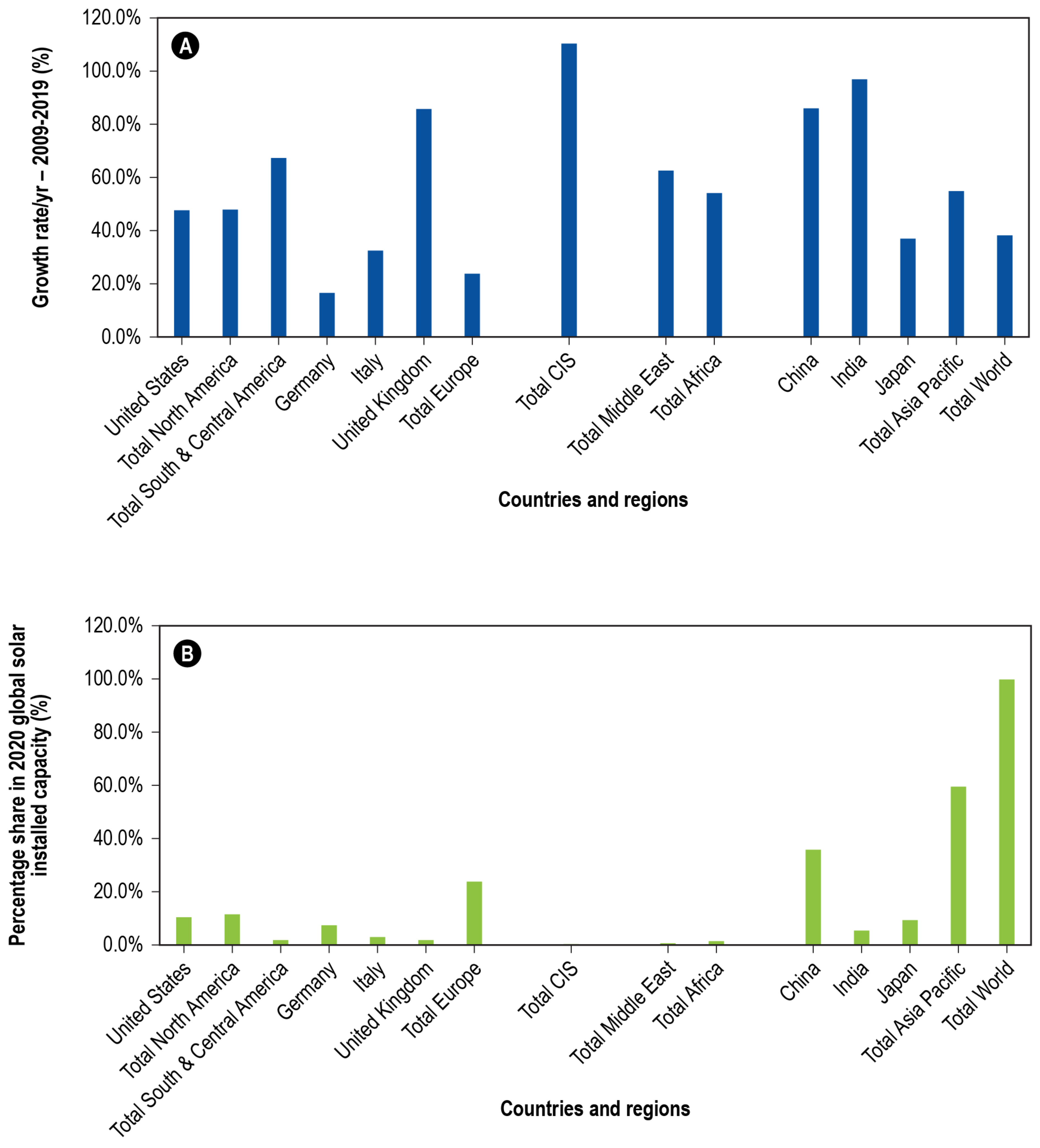
| CSP Technologies | Solar Cells | |
|---|---|---|
| Advantages | ||
| Renewable, clean, natural energy source. | Clean electricity generation without emitting greenhouse gases and environmentally friendly. | |
| Low operating costs | Low operating costs | |
| High efficiency | Relatively low efficiency, however, low maintenance, easy installation, produce direct electricity without involving moving parts | |
| Scalable to more than 100 MW | Both small-scale (rooftop) and large-scale can be built and easily scalable. | |
| Disadvantages | ||
| Dependent on plentiful direct sunlight | Dependent on plentiful direct sunlight | |
| Typically high construction and installation costs | Cost is reduced over time; however, still cost-prohibitive for many rural areas | |
| A large amount of land is needed | The large-scale solar panel requires a substantial amount of land |
| Top 12 Solar Power Plants in the World | |||
|---|---|---|---|
| S. No. | Name of Solar Power Plant | Year of Commission | Current Plant Capacity |
| 1. | Huanghe Hydropower Development Solar Park, China [46,47] | 2020 | 2200 MW |
| 2. | Bhadla Solar Park, Rajasthan, India [46,47] | 2021 | 2045 MW |
| 3. | Pavagada Solar Park (Shakti Sthala), Karnataka, India [48] | 2018 | 2000 MW |
| 4. | Benban Solar Park, Benban Aswan, Egypt [49] | 2019 | 1800 MW |
| 5. | Tengger Desert Solar Park, China [50] | 2017 | 1547 MW |
| 6. | Noor Abu Dhabi, Sweinhan, Abu Dhabi, UAE [51] | 2019 | 1200 MW |
| 7. | Datong Solar Power Top Runner Base, China [50] | 2016 | 1070 MW |
| 8. | Mohammed bin Rashid Al Maktoum Solar Park, UAE [52] | 2020 | 1013 MW |
| 9. | Kurnool Ultra Mega Solar Park, Andhra Pradesh, India [53] | 2017 | 1000 MW |
| 10. | NP Kunta Ultra Mega Solar Park, Andhra Pradesh, India [54] | 2016 | 1000 MW |
| 11. | Longyangxia Dam Solar Park, China [50] | 2015 | 850 MW |
| 12. | Villanueva Solar Project, Mexico [54] | 2018 | 828 MW |
| Top 12 solar projects in India | |||
| 1. | Bhadla Solar Park, Rajasthan [46,47] | 2021 | 2045 MW |
| 2. | Pavagada Solar Park (Shakti Sthala), Karnataka [48] | 2018 | 2000 MW |
| 3. | Kurnool Ultra Mega Solar Park, Andhra Pradesh [52] | 2017 | 1000 MW |
| 4. | NP Kunta Ultra Mega Solar Park, Andhra Pradesh [53] | 2021 | 978.5 MW |
| 5. | Rewa Ultra Mega Solar, Madhya Pradesh [55] | 2020 | 750 MW |
| 6. | Kamuthi Solar Power Project, Tamil Nadu [56] | 2016 | 648 MW |
| 7. | Charanka Solar Park, Gujarat [57] | 2012 | 600 MW |
| 8. | Kadapa Ultra Mega Solar Park, Andhra Pradesh [58] | 2019 | 250 MW |
| 9. | Welspun Solar MP Project, Madhya Pradesh [59] | 2014 | 151 MW |
| 10. | Sakri Solar Plant, Maharashtra [60] | 2013 | 125 MW |
| 11. | Maharashtra I Solar Plant, Maharashtra [61] | 2017 | 67.2 MW |
| 12. | Bitta Solar Power Plant, Gujarat [62] | 2011 | 40 MW |
| Thermal Power | Hydroelectric Power | Nuclear Power | Solar Power |
|---|---|---|---|
| Works on Modified Rankine Cycle. | The potential energy of water is converted to kinetic energy | Thermonuclear fission. | Sun energy is converted to electric and thermal energy |
| Need a large space | Need a large amount of water | Requires relatively less space | Relatively large space is needed |
| Coal as a fuel is used | Water as a fuel is used | Uranium (U235) and other radioactive metals. | Sun energy |
| The overall efficiency of 30–32% | The overall efficiency of 85% to 90% | Efficiency is about 55% | Solar panels efficiency is about 14–15% |
| Lower than hydroelectric | Very high | Highest | Relatively low |
| Maintenance cost high | Maintenance cost low | Maintenance cost very high | Maintenance cost low |
| Transmission cost is low | Transmission cost is high | Transmission cost is low | Transmission cost is low |
| Lifetime 30–40 years | Lifetime around 100 years | Lifetime 40–60 years | Lifetime 15–20 years |
| Air and soil pollution | Affects aquatic life and natural rivers and lakes | Radioactive waste disposal is a big issue | Less environmental pollution |
| Renewable Energy–Solar (Installed Capacity, Gigawatt) (Year Wise) | |||||||||||
|---|---|---|---|---|---|---|---|---|---|---|---|
| 2010 | 2011 | 2012 | 2013 | 2014 | 2015 | 2016 | 2017 | 2018 | 2019 | 2020 | |
| US | 2.0 | 5.2 | 8.1 | 11.8 | 16.0 | 21.7 | 33.0 | 41.4 | 51.4 | 58.9 | 73.8 |
| Total North America | 2.3 | 5.7 | 9.0 | 13.1 | 17.9 | 24.4 | 36.0 | 44.9 | 57.1 | 66.7 | 82.8 |
| Total S. and C. America | 0.1 | 0.2 | 0.3 | 0.5 | 0.8 | 1.8 | 2.7 | 5.2 | 7.5 | 10.8 | 15.1 |
| Germany | 18.0 | 25.9 | 34.1 | 36.7 | 37.9 | 39.2 | 40.7 | 42.3 | 45.2 | 49.0 | 53.8 |
| Italy | 3.6 | 13.1 | 16.8 | 18.2 | 18.6 | 18.9 | 19.3 | 19.7 | 20.1 | 20.9 | 21.6 |
| United Kingdom | 0.1 | 1.0 | 1.8 | 2.9 | 5.5 | 9.6 | 11.9 | 12.8 | 13.1 | 13.3 | 13.6 |
| Total Europe | 30.1 | 53.6 | 71.7 | 81.9 | 88.8 | 97.5 | 104.7 | 113.5 | 124.4 | 146.3 | 167.8 |
| Total CIS | 0.0 | 0.0 | 0.0 | 0.0 | 0.1 | 0.2 | 0.2 | 0.4 | 1.0 | 2.3 | 3.2 |
| Total Middle East | 0.1 | 0.2 | 0.3 | 0.5 | 0.8 | 1.0 | 1.5 | 2.1 | 3.3 | 5.5 | 6.5 |
| Total Africa | 0.2 | 0.3 | 0.3 | 0.7 | 1.6 | 1.9 | 3.0 | 4.7 | 7.1 | 8.3 | 9.5 |
| China | 1.0 | 3.1 | 6.7 | 17.7 | 28.4 | 43.5 | 77.8 | 130.8 | 175.0 | 204.6 | 253.8 |
| India | 0.1 | 0.6 | 1.0 | 1.4 | 3.4 | 5.4 | 9.7 | 17.9 | 27.1 | 34.9 | 39.0 |
| Japan | 3.6 | 4.9 | 6.4 | 12.1 | 19.3 | 28.6 | 38.4 | 44.2 | 55.5 | 61.5 | 67.0 |
| Total Asia Pacific | 7.3 | 12.1 | 19.8 | 39.1 | 61.6 | 90.6 | 143.2 | 213.6 | 282.5 | 341.0 | 422.6 |
| Total World | 40.1 | 72.0 | 101.4 | 135.7 | 171.6 | 217.5 | 291.3 | 384.5 | 482.9 | 580.8 | 707.5 |
Publisher’s Note: MDPI stays neutral with regard to jurisdictional claims in published maps and institutional affiliations. |
© 2022 by the authors. Licensee MDPI, Basel, Switzerland. This article is an open access article distributed under the terms and conditions of the Creative Commons Attribution (CC BY) license (https://creativecommons.org/licenses/by/4.0/).
Share and Cite
Pandey, A.; Pandey, P.; Tumuluru, J.S. Solar Energy Production in India and Commonly Used Technologies—An Overview. Energies 2022, 15, 500. https://doi.org/10.3390/en15020500
Pandey A, Pandey P, Tumuluru JS. Solar Energy Production in India and Commonly Used Technologies—An Overview. Energies. 2022; 15(2):500. https://doi.org/10.3390/en15020500
Chicago/Turabian StylePandey, Aditya, Pramod Pandey, and Jaya Shankar Tumuluru. 2022. "Solar Energy Production in India and Commonly Used Technologies—An Overview" Energies 15, no. 2: 500. https://doi.org/10.3390/en15020500
APA StylePandey, A., Pandey, P., & Tumuluru, J. S. (2022). Solar Energy Production in India and Commonly Used Technologies—An Overview. Energies, 15(2), 500. https://doi.org/10.3390/en15020500







